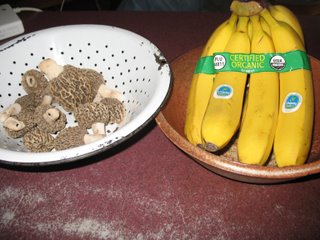Day-o

What is wrong with this picture? Yes, one bowl contains bananas, the other morel mushrooms. The bowls are sitting next to each other on the same kitchen counter. So what's wrong with that?
I'll let Barbara Kingsolver answer the question. Ms. Kingsolver, long a beloved fiction writer, has written a surprising bestseller titled Animal, Vegetable, Miracle, which depicts her decision, along with her husband and two daughters, to eat for one full year only food that is organically grown and locally produced, either nearby or from their own labor on their Appalachian farm. Here is an excerpt from an interview with Barbara Kingsolver, that appeared in the magazine, Shambala Sun, in July 2007.
(Interviewer): What was the most difficult thing about eating locally for a year?
Barbara Kingsolver: Everyone asks that, and I think the answer people expect is that it was really hard to give up some particular food, but it really wasn't. Our undertaking was to focus on what was new, what was good, what was fresh in every season, and every month there was something to celebrate. By concentrating on that, we really forgot about what we were missing. It didn't cross my mind when I was hunting morels that I was giving up bananas. I mean, who needs them?
Uh-oh. The bananas and morels sitting side by side are actually sitting on my kitchen counter -- the picture was taken about a month ago when I happened to re-read that interview. As far as Morel mushrooms go, there may be some rather staid strains that reliably show up in the same place each year, but the morels on our farm seem to be coyote tricksters, whose appearance and disappearance are totally unpredictable. Now you see 'em one year under the old apple tree, next year you definitely don't! This particular batch of morels popped out as my son was looking for a chain in some metal junk next to our garage. Never been there before! No mushroom guides suggesting a perusal of automotive junk!
So my son brought his prize to the house, I plunked them in a bowl next to their Caribbean visitors, and went Hmmm. Muted earthy brown next to bright fluorescent yellow. Point of origin: fifty feet vs five thousand miles. Historical baggage: A native North American wild food vs pillaging of land and native South American populations by some of the prototype multinational corporations at the turn of the the century. The term, "banana republic", was penned by O. Henry to refer to a dictatorship servile to the controlling moneyed interests in that land. Nope, not just a hip and outdoorsy clothing brand. Ouch.
So now the ubiquitous banana has a prime place in every supermarket produce section, and on most kitchen counters, I'll warrant. And I understand that the bananas we get are the "Red Delicious" of the banana world. I heard a fellow who had visited Costa Rica describe the incredible variety of this tropical fruit in its native country, with creamy, pudding-like textures and complex flavors that are almost unrecognizable from the same fruit that lands on our distant shores, and that everybody knows is picked green and gassed to ripen. How could that taste good?
Yet the banana boats keep landing and Chiquita Banana has convinced the majority of our population that she is a key player in a healthy diet. Barbara Kingsolver got along without them for a year, and I could too. They never really rocked my boat. But the hard-working, fast-moving farmer on this land seems to find the banana's portability and ease of preparation a ready answer for what to eat when there is really no time to eat! I have pulled off the tomato moratorium (Frog Log, 2/08/08) but that's seasonal and I don't know if I could say yes we have no bananas quite yet. But I'm thinking about it.
Although I never made a smoothie or muffins from Morel mushrooms -- and hope I never have to! The comparison of the two food items is not really parallel, but does give, to use a cliche, food for thought.
So my book club, along with every other book club in the country, read Animal, Vegetable, Miracle, and agreed that everyone would bring locally produced food to share at the meeting. This was in May so there was a lot of rhubarb and a several uses for hard-boiled eggs! I was feeling pretty smug as, thanks to being "professionals", we already had vegetables to pick from the garden. I decided to make a spinach salad. Spinach is so hardy that we can plant it very early and have a good crop by mid-May. And despite minimal attention, this particular patch had grown vigorously since the first planting that had been immediately followed by a snowstorm. The leaves were so crisp and dark green, they almost looked like they were dressed up to go to town! I actually don't think my description can do justice to this hard-working harbinger of Spring in the garden, so I'll add another photo to the blog to show the lush leaves that practically look like they're ready jump in the truck!
Hey, wait a minute -- how did that picture of the spinach patch already get in the Frog Log???

Comments
Post a Comment